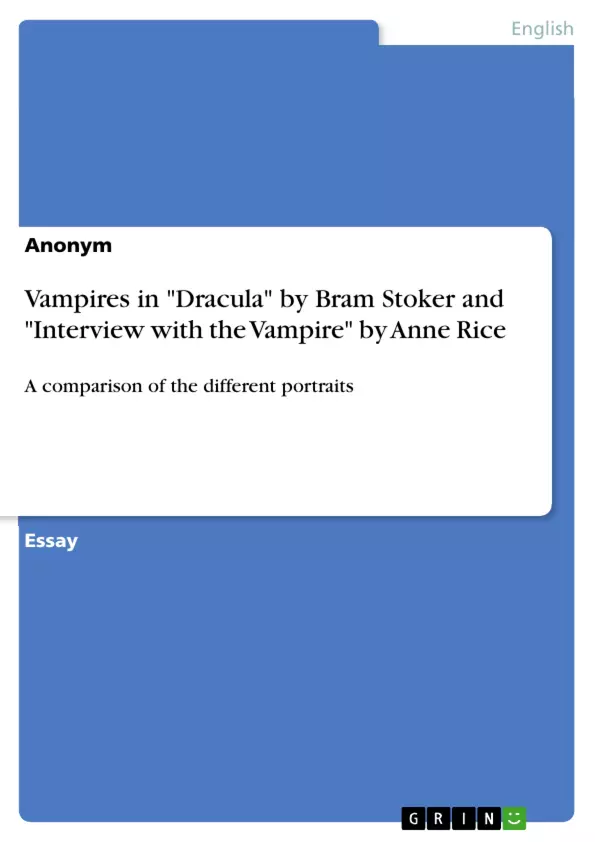The paper shows the differences between the different portraits of vampires in Bram Stoker’s novel “Dracula” and Anne Rice’s “Interview with the Vampire”.
The vampires today own seductive features since they are mainly very good-looking and irresistible. These are characteristics the ancient vampire in literature do not have. Bram Stoker’s Dracula laid the foundation for the vampire cult in 1897.
In 1976 Anne Rice published her novel Interview with the Vampire. Her novels turned the image of vampire’s upside down because her vampires become good-looking and live with us, since her protagonists were not only monstrous creatures. They have feelings and thoughts and also human problems.
Table of Contents
- 1. Introduction
- 2. Dracula
- 2.1 Plot
- 2.2 Appearance
- 3. Interview with a Vampire
- 3.1 Plot
- 3.2 Appearance
- 4. Conclusion
- 5. Works Cited
Objectives and Key Themes
This paper aims to compare and contrast the portrayals of vampires in Bram Stoker's Dracula and Anne Rice's Interview with a Vampire, highlighting the evolution of the vampire figure in literature. The analysis focuses on the differences in plot structure, character depiction, and the overall thematic implications of each work.
- Evolution of the Vampire Figure in Literature
- Comparison of Plot Structures and Narrative Techniques
- Analysis of Character Portrayals and their Symbolic Significance
- Exploration of the Thematic Differences between the Two Novels
- The Role of the Vampire in Challenging Traditional Beliefs
Chapter Summaries
1. Introduction: This introductory chapter establishes the central theme of the paper: comparing the contrasting portrayals of vampires in Bram Stoker's Dracula and Anne Rice's Interview with the Vampire. It highlights the shift in vampire depiction from monstrous creatures to seductive and relatable figures, emphasizing the significant change in the vampire's image between 1897 and 1976. The introduction sets the stage for a detailed comparison, laying the groundwork for analyzing the evolution of the vampire archetype in literature. It briefly touches upon earlier literary works featuring vampires, establishing context for Stoker's influential role in shaping the modern vampire mythos.
2. Dracula: This chapter provides a detailed overview of Bram Stoker's Dracula. It focuses on the novel's structure as a collection of documents, emphasizing the authenticity and realism it conveys despite the fantastical subject matter. The analysis delves into the plot, covering Jonathan Harker's experiences in Dracula's castle, Dracula's arrival in England, Lucy's tragic transformation, and the eventual hunt and destruction of the Count. The chapter underscores the one-dimensional portrayal of Dracula and the female vampires as antagonists, devoid of complex inner lives or relatable characteristics. The discussion extends to the symbolic interpretations of Dracula's features, his supernatural abilities, and his mirroring of Harker, suggesting the Count's possible status as a projection of suppressed desires within the human psyche. The chapter concludes by highlighting the novel's impact on the vampire genre and its relationship to religious themes, portraying Dracula as a reversal of Christ's figure.
Keywords
Vampire literature, Bram Stoker, Anne Rice, Dracula, Interview with a Vampire, gothic fiction, character comparison, narrative structure, symbolism, religious themes, evolution of the vampire myth.
Frequently Asked Questions: A Comparative Analysis of Vampires in Dracula and Interview with a Vampire
What is the purpose of this paper?
This paper compares and contrasts the portrayals of vampires in Bram Stoker's Dracula and Anne Rice's Interview with a Vampire, analyzing how the vampire figure has evolved in literature. It focuses on plot structures, character depictions, and thematic implications.
What are the key themes explored in this analysis?
Key themes include the evolution of the vampire figure, a comparison of plot structures and narrative techniques, an analysis of character portrayals and their symbolic significance, an exploration of thematic differences between the novels, and the role of the vampire in challenging traditional beliefs.
What is covered in the chapter on Dracula?
The chapter on Dracula provides a detailed overview of the novel, focusing on its structure as a collection of documents. It analyzes the plot, including Jonathan Harker's experiences, Dracula's arrival in England, Lucy's transformation, and the vampire hunt. It also examines the one-dimensional portrayal of Dracula and the female vampires as antagonists, and explores symbolic interpretations of Dracula's features and abilities, including his possible mirroring of Harker. The chapter concludes by highlighting the novel's impact on the vampire genre and its relationship to religious themes.
What does the introduction discuss?
The introduction establishes the central theme of comparing vampire portrayals in Dracula and Interview with a Vampire, highlighting the shift in vampire depiction from monstrous creatures to more relatable figures. It sets the stage for a detailed comparison and briefly touches upon earlier vampire literature.
What aspects of Interview with a Vampire are analyzed (implied)?
While the provided text focuses primarily on Dracula, it implies that a similar in-depth analysis of Interview with a Vampire is included in the full paper, contrasting its portrayal of vampires with that of Stoker's work. This would likely include a comparative analysis of plot, characterization, and thematic elements.
What are the key words associated with this analysis?
Key words include vampire literature, Bram Stoker, Anne Rice, Dracula, Interview with a Vampire, gothic fiction, character comparison, narrative structure, symbolism, religious themes, and the evolution of the vampire myth.
What is included in the table of contents?
The table of contents includes an introduction, chapters on Dracula (with sub-sections on plot and appearance), and Interview with a Vampire (with sub-sections on plot and appearance), a conclusion, and a works cited section.
- Quote paper
- Anonym (Author), 2020, Vampires in "Dracula" by Bram Stoker and "Interview with the Vampire" by Anne Rice, Munich, GRIN Verlag, https://www.grin.com/document/1244979



